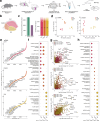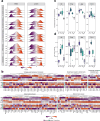An integrated transcriptomic and proteomic map of the mouse hippocampus at synaptic resolution
- PMID: 40858553
- PMCID: PMC12381143
- DOI: 10.1038/s41467-025-63119-5
An integrated transcriptomic and proteomic map of the mouse hippocampus at synaptic resolution
Abstract
Understanding the brain's molecular diversity requires spatially resolved maps of transcripts and proteins across regions and compartments. Here, we performed deep spatial molecular profiling of the mouse hippocampus, combining microdissection of 3 subregions and 4 strata with fluorescence-activated synaptosome sorting, transcriptomics, and proteomics. This approach revealed thousands of locally enriched molecules spanning diverse receptor, channel, metabolic, and adhesion families. Integration of transcriptome and proteome data highlighted proteins tightly linked to or decoupled from mRNA availability, in part due to protein half-life differences. Incorporation of translatome data identified roles for protein trafficking versus local translation in establishing compartmental organization of pyramidal neurons, with distal dendrites showing increased reliance on local protein synthesis. Classification of CA1 synapses revealed contributions from kinases, cytoskeletal elements, and adhesion molecules in defining synaptic specificity. Together, this study provides a molecular atlas of the hippocampus and its synapses (syndive.org), and offers insights into spatial transcript-protein relationships.
© 2025. The Author(s).
Conflict of interest statement
Competing interests: The authors declare no competing interests.
Figures







References
-
- Lein, E. S. et al. Genome-wide atlas of gene expression in the adult mouse brain. Nature445, 168–176 (2007). - PubMed
MeSH terms
Substances
LinkOut - more resources
Full Text Sources
Molecular Biology Databases
Miscellaneous

